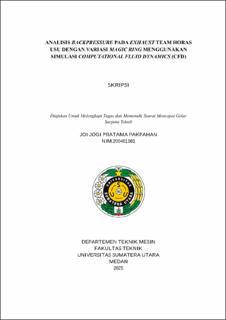Analisis BackPressure pada Exhaust Team Horas USU dengan Variasi Magic Ring Menggunakan Simulasi Computational Fluid Dynamics (CFD)
Backpressure Analysis on Team Horas USU Exhaust with Magic Ring Variations Using Computational Fluid Dynamics (CFD) Simulation

Date
2025Author
Pakpahan, Joi Jogi Pratama
Advisor(s)
Nur, Taufiq Bin
Metadata
Show full item recordAbstract
This study analyzes backpressure in the Team Horas USU exhaust system with
variations in the number of holes in the magic ring using CFD simulation to
understand its impact on pressure distribution, backpressure, and the thermal
efficiency of the Yanmar L40AE-S diesel engine. The exhaust geometry was modeled
using SolidWorks, meshed with ANSYS, and simulated using a CFD solver. The number
of magic ring holes varied between 6, 8, and 10, with engine speeds ranging from 800
to 3100 rpm. The results indicate that increasing the number of magic ring holes
reduces backpressure and results in a more uniform pressure distribution. The magic
ring with 6 holes produced the highest backpressure of 3083 Pa at 2600 rpm and the
lowest of 401 Pa at 800 rpm, while the 8-hole magic ring exhibited a maximum
backpressure of 9246 Pa at 3100 rpm and a minimum of 2169 Pa at 800 rpm. The 10-
hole magic ring recorded the highest backpressure of 3273 Pa at 3100 rpm and the
lowest of 316 Pa at 800 rpm. In conclusion, increasing the number of magic ring holes
can reduce backpressure and improve engine thermal efficiency by decreasing exhaust
gas resistance. Future research is recommended to combine CFD simulations with
experimental testing for more accurate and realistic data.
Collections
- Undergraduate Theses [972]
